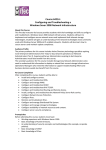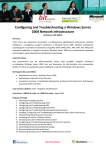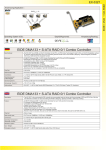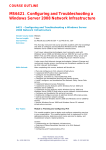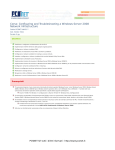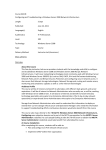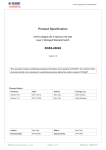Download PIANO DIDATTICO MOC 6421A Configuring and Troubleshooting a
Transcript
PIANO DIDATTICO MOC 6421A Configuring and Troubleshooting a Windows Server 2008 Network Infrastructure Installing and Configuring Servers Installing Windows Server 2008 Managing Server Roles and Features Overview of the Server Core Installation Option Identifying Server Types Installing and Configuring Server Roles and Features Configuring Server Core and Performing Basic Management Tasks Identify the system requirements and process for installing Windows Server 2008. Describe the difference between server roles and features. Describe the benefits of and roles supported by a Server Core installation. Configuring and Troubleshooting DNS Installing the DNS Server Role Configuring the DNS Server Role Configuring DNS Zones Configuring DNS Zone Transfers Managing and Troubleshooting DNS Configuring a DNS Infrastructure Monitoring and Troubleshooting DNS Install the DNS Server role. Configure the DNS Server role to support various query types. Configure DNS zones. Configure DNS zone transfers. Manage DNS zone records and troubleshoot DNS using various tools. Configuring and Managing WINS Overview of the Windows Internet Name Service Managing the WINS Server Configuring WINS Replication Migrating from WINS to DNS Installing WINS Configuring WINS Burst Handling Configuring WINS Replication Migrating from WINS to DNS Install and configure the Windows Internet Name Service. Manage WINS client records. Configure and manage WINS replication. Migrate a WINS infrastructure to DNS. Configuring and Troubleshooting DHCP Overview of the DHCP Server Role Configuring DHCP Scopes and Options Managing a DHCP Database Monitoring and Troubleshooting DHCP Securing DHCP Installing and Authorizing the DHCP Server Role Configuring a DHCP Scope Troubleshooting Common DHCP Issues Describe how DHCP works. Configure DHCP scopes and options. Manage a DHCP database. Monitor and troubleshoot DHCP. Secure DHCP. Configuring and Troubleshooting IPv6 TCP/IP Overview of IPv6 Coexistence with IPv6 IPv6 Tunneling Technologies Transitioning from IPv4 to IPv6 Troubleshooting IPv6 Configuring a New IPv6 Network and Client Configuring an ISATAP Router to Enable Communication Between an IPv4 Network and an IPv6 Network Transitioning to an IPv6-Only Network Describe the benefits and considerations of IPv6. Describe how IPv6 can coexist with IPv4 environments. Describe IPv6 tunneling technologies used to interoperate with IPv4 networks. Describe the process used to migrate from IPv4 to IPv6. Troubleshoot IPv6 connectivity. Configuring and Troubleshooting Routing and Remote Access Configuring Network Access Configuring VPN Access Overview of Network Policies Overview of the Connection Manager Administration Kit Troubleshooting Routing and Remote Access Configuring Routing and Remote Access as a VPN Remote Access Solution Configuring a Custom Network Policy Configuring Logging Configuring a Connection Profile Install and configure the Routing and Remote Access service. Configure VPN access. Configure network policies. Configure a connection profile using the Connection Manager Administration Kit. Troubleshoot Routing and Remote Access. Installing, Configuring, and Troubleshooting the Network Policy Server Role Service Installing and Configuring a Network Policy Server Configuring RADIUS Clients and Servers NPS Authentication Methods Monitoring and Troubleshooting a Network Policy Server Installing and Configuring the Network Policy Server Role Service Configuring a RADIUS Client Configuring Certificate Auto-Enrollment Install and configure the Network Policy Server role. Configure a RADIUS client and server. Describe NPS authentication methods. Monitor and troubleshoot a Network Policy server. Configuring Network Access Protection Overview of Network Access Protection How NAP Works Configuring NAP Monitoring and Troubleshooting NAP Configuring NAP for DHCP Clients Configuring NAP for VPN Clients Describe the benefits and uses of NAP. Describe how NAP works in various access scenarios. Configure NAP. Monitor and troubleshoot NAP. Configuring IPsec Overview of IPsec Configuring Connection Security Rules Configuring IPsec NAP Enforcement Preparing the Network Environment for IPsec NAP Enforcement Configuring and Testing IPsec NAP Enforcement Describe the benefits and uses of IPsec. Configure Connection Security rules. Configure IPsec NAP enforcement. Monitoring and Troubleshooting IPsec Monitoring IPsec Activity Troubleshooting IPsec Monitoring IPSec Connectivity Configuring Connection Security Troubleshooting IPSec Monitor IPsec activity. Troubleshoot IPsec. Configuring and Managing Distributed File System DFS Overview Configuring DFS Namespaces Configuring DFS Replication Installing the Distributed File System Role Service Creating a DFS Namespace Configuring Folder Targets and Folder Replication Viewing Diagnostic Reports for Replicated Folders Describe the Distributed File System. Manage DFS namespaces. Configure DFS replication. Configuring and Managing Storage Technologies Windows Server 2008 Storage Management Overview Managing Storage Using File Server Resource Manager Configuring Quota Management Implementing File Screening Managing Storage Reports Installing the FSRM Role Service Configuring Storage Quotas Configuring File Screening Generating Storage Reports Describe storage management solutions included in Windows Server 2008. Manage storage using File Server Resource Manager (FSRM). Configure quota management using FSRM. Implement file screening using FSRM. Manage storage reports. Configuring Availability of Network Resources and Content Backing Up Data Configuring Shadow Copies Providing Server and Service Availability Configuring Windows Server Backup and Restore Configuring Shadow Copying Configuring Network Load Balancing Back up data. Configure shadow copies. Provide server and service availability. Configuring Server Security Compliance Securing a Windows Infrastructure Using Security Templates to Secure Servers Configuring an Audit Policy Overview of Windows Server Update Services Managing Windows Server Update Services Configuring and Analyzing Security Analyzing Security Templates Configuring Windows Software Update Services Secure a server role within a Windows infrastructure. Secure servers using security templates. Configure an audit policy. Describe the use of Windows Server Update Services. Manage updates using Windows Server Update Services.



